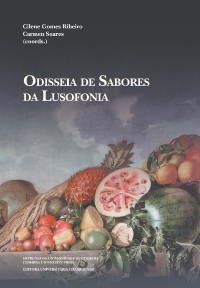Please use this identifier to cite or link to this item:
https://hdl.handle.net/10316.2/38426| DC Field | Value | Language |
|---|---|---|
| dc.contributor.author | Gomes, João Pedro | |
| dc.date.accessioned | 2016-01-20T17:12:22Z | |
| dc.date.accessioned | 2020-09-10T15:16:21Z | - |
| dc.date.available | 2016-01-20T17:12:22Z | |
| dc.date.available | 2020-09-10T15:16:21Z | - |
| dc.date.issued | 2015 | - |
| dc.identifier.isbn | 978-989-26-1085-6 | |
| dc.identifier.isbn | 978-989-26-1086-3 (PDF) | |
| dc.identifier.issn | 2183-6523 | |
| dc.identifier.uri | https://hdl.handle.net/10316.2/38426 | - |
| dc.description.abstract | The Portuguese maritime enterprise to the south of Cape Bojador, started in the 30’s of the 15th century by Prince Henry and boosted in the 40’s, resulted in a vast array of literary creations that we can call the Travel Writing, whose main objective were the enhancement of the pioneered seas (and the sailors responsible) and the newly discovered land. Chroniclers, sailors and merchants would contribute thus to the diffusion of chronicles texts and relações, imprinting their own visions of the African, their continent, their habits and customs, and making possible the circulation of these productions throughout Europe and urging the old continent, avid curiosity for new discoveries, new plants, new cultures. These reports, focused on observation / characterization of this faraway and exotic Other and its transmission to all non-direct observers, were mainly held on the description of habits and customs, from an European reference of society, culture and civility. These texts allows us to identify, to list and realize eating habits and cultures associated with both parts, the observed (African) as the observer (the European), the relationship established between the two parties, as well as the operated cultural transfers, in this particular case, on the geographical space between the River Senegal, the Gambia River and the Cape Verde archipelago. | eng |
| dc.description.abstract | As empreitadas marítimas portuguesas a sul do Cabo Bojador, iniciadas durante os anos 30 do século XV pelo infante D. Henrique e fortemente dinamizadas partir dos anos 40, resultaram num vasto rol de criações literárias que podemos denominar de Literatura de Viagem, cujo objetivo principal era o de enaltecer os mares desbravados (e os marinheiros responsáveis) e as novas terras visitadas. Cronistas, marinheiros e mercadores contribuiriam, assim, para a difusão de textos cronísticos e relações nos quais imprimiam as suas visões da população africana, do seu continente, hábitos e costumes, fazendo circular estas produções por todo o espaço europeu e incitando a curiosidade do velho continente, ávido de novas descobertas, novas plantas, novas culturas. Estes relatos, focados na observação/ caracterização deste Outro longínquo e exótico e na transmissão da informação a todos os não observadores diretos, detinham-se na descrição de hábitos e costumes, que tinha por ponto de partida o referente europeu de sociedade, cultura e civilidade. A leitura desses textos permite, assim, identificar, elencar e perceber hábitos e culturas alimentares associados tanto ao observado (o africano) como ao observador (o europeu), a relação estabelecidas entre as duas partes, bem como as transferências culturais operadas, neste caso específico, no espaço geográfico compreendido entre o Rio Senegal, o Rio Gâmbia e o arquipélago de Cabo Verde. | por |
| dc.language.iso | por | - |
| dc.publisher | Imprensa da Universidade de Coimbra | por |
| dc.relation.ispartof | http://hdl.handle.net/10316.2/38423 | por |
| dc.rights | open access | - |
| dc.subject | lusophony | eng |
| dc.subject | history of Africa | eng |
| dc.subject | discoveries | eng |
| dc.subject | gastronomy | eng |
| dc.subject | food | eng |
| dc.subject | lusofonia | por |
| dc.subject | história de África | por |
| dc.subject | descobrimentos | por |
| dc.subject | gastronomia | por |
| dc.subject | alimentação | por |
| dc.title | Folgam de comer os comeres feitos ao nosso modo: práticas e culturas alimentares entre o Rio Senegal e o Rio Gâmbia (séculos XV e XVI) | por |
| dc.title.alternative | “Folgam de comer os comeres feitos ao nosso modo”: food cultures and practices between Senegal River and Gambia River (XV and XVI century) | eng |
| dc.type | bookPart | por |
| uc.publication.collection | Série DIAITA: Scripta & Realia | por |
| uc.publication.firstPage | 67 | - |
| uc.publication.lastPage | 107 | - |
| uc.publication.location | Coimbra | por |
| dc.identifier.doi | 10.14195/978-989-26-1086-3_3 | - |
| uc.publication.section | Parte II: sabores da lusofonia: integrações multiculturais | por |
| uc.publication.digCollection | PB | por |
| uc.publication.orderno | 3 | - |
| uc.publication.area | Artes e Humanidades | por |
| uc.publication.bookTitle | Odisseia de sabores da lusofonia | - |
| uc.publication.manifest | https://dl.uc.pt/json/iiif/10316.2/38426/212849/manifest?manifest=/json/iiif/10316.2/38426/212849/manifest | - |
| uc.publication.thumbnail | https://dl.uc.pt/retrieve/11193776 | - |
| uc.publication.parentItemId | 54561 | - |
| uc.itemId | 70608 | - |
| item.grantfulltext | open | - |
| item.fulltext | With Fulltext | - |
| Appears in Collections: | Odisseia de sabores da lusofonia | |
Files in This Item:
| File | Description | Size | Format | |
|---|---|---|---|---|
| folgam_de_comer_os_comeres_feitos_ao_nosso_modo.pdf | 6.02 MB | Adobe PDF |  |
Items in DSpace are protected by copyright, with all rights reserved, unless otherwise indicated.
